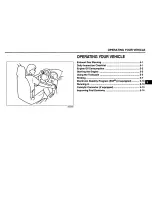
09 Wheels and tyres
09
304
Tyres - maintenance
Amongst other things, the function of the
tyres is to carry load, provide grip on the road
surface, dampen vibration and protect the
wheel from wear.
Driving characteristics
Tyres greatly affect the car's driving characte-
ristics. The type of tyre, dimensions, tyre
pressure and speed rating are important for
how the car performs.
Tyre age
All tyres older than 6 years old should be
checked by an expert even if they seem
undamaged. Tyres age and decompose, even
if they are hardly ever or never used. The
function can therefore be affected. This
applies to all tyres that are stored for future
use. Examples of external signs which indi-
cate that the tyre is unsuitable for use are
cracks or discoloration.
New tyres
Tyres are perishable. After a few years they
begin to harden at the same time as the fric-
tion capacity/characteristics gradually deteri-
orate. For this reason, aim to get as fresh
tyres as possible when you replace them.
This is especially important with regard to
winter tyres. The last four digits in the
sequence mean the week and year of manu-
facture. This is the tyre's DOT marking
(Department of Transportation), and this is
stated with four digits, for example 1510. The
tyre in the figure was manufactured in week
15 of 2010.
Summer and winter wheels
When summer and winter wheels are
changed the wheels should be marked with
which side of the car they were mounted on,
for example
L
for left and
R
for right.
Wear and maintenance
Correct tyre pressure (p. 306) results in more
even wear. Driving style, tyre pressure, cli-
mate and road condition affect how quickly
your tyres age and wear.
To avoid differences in tread depth and to
prevent wear patterns arising, the front and
rear wheels can be switched with each other.
A suitable distance for the first change is
approx. 5000 km and then at 10000 km inter-
vals.
Volvo recommends that an authorised Volvo
workshop is contacted for checking if you are
uncertain about tread depth. If significant dif-
ferences in wear (> 1 mm difference in tread
depth) between tyres have already occurred,
then the least worn tyres must always be fit-
ted on the rear. Understeer is normally easier
to correct than oversteer, and leads to the car
continuing forwards in a straight line rather
than having the rear end skidding to one side,
resulting in possible complete loss of control
over the car. This is why it is important for the
rear wheels never to lose grip before the front
wheels.
WARNING
A damaged tyre may lead to loss of control
over the car.
Содержание S 80
Страница 1: ...WEB EDITION OWNER S MANUAL ...
Страница 2: ......
Страница 12: ...Table of contents 10 12 12 Alphabetical Index Alphabetical Index 404 ...
Страница 13: ...Table of contents 11 ...
Страница 14: ...INTRODUCTION ...
Страница 27: ...SAFETY ...
Страница 55: ...INSTRUMENTS AND CONTROLS ...
Страница 57: ...03 Instruments and controls 03 55 Overview left hand drive cars ...
Страница 60: ... 03 Instruments and controls 03 58 Overview right hand drive cars ...
Страница 99: ...03 Instruments and controls 03 97 Templates for halogen headlamps ...
Страница 124: ...CLIMATE CONTROL ...
Страница 148: ...LOADING AND STORAGE ...
Страница 149: ...05 Loading and storage 05 147 Storage spaces Overview of storage spaces in the passenger compartment ...
Страница 158: ...LOCKS AND ALARM ...
Страница 184: ...DRIVER SUPPORT ...
Страница 249: ...STARTING AND DRIVING ...
Страница 305: ...WHEELS AND TYRES ...
Страница 333: ...09 Wheels and tyres 09 331 Country Area Brazil Ukraine ...
Страница 334: ... 09 Wheels and tyres 09 332 Country Area Israel ...
Страница 338: ...MAINTENANCE AND SERVICE ...
Страница 388: ...SPECIFICATIONS ...
Страница 405: ...11 Specifications 11 403 ...
Страница 417: ......
Страница 418: ...TP 18974 English Int AT 1517 MY16 Printed in Sweden Göteborg 2015 Copyright 2000 2015 Volvo Car Corporation ...
















































